Evaluating Visible–Infrared Imaging Radiometer Suite Imagery for Developing Near-Real-Time Nationwide Vegetation Cover Monitoring in Indonesia
Abstract
:1. Introduction
2. Materials and Methods
2.1. Satellite Data
2.2. Image Data Filtering in the Temporal Domain
2.3. Vegetation Cover Change Detection
2.4. Accuracy Assessment
2.4.1. Sampling Design for Accuracy Test
2.4.2. Evaluating Model Performance
- (a)
- Omission error, which was calculated as the ratio of the number of changed pixels in the ground “truth” polygons that were not identified by the method to the total number of changed pixels in Landsat’s reference change bitmap;
- (b)
- Accuracy, which was determined as the ratio of the number of changed pixels in the ground “truth” polygons that were also identified by the method to the total number of changed pixels in Landsat’s reference change bitmap.
3. Results
3.1. Vegetation Cover Change in VIIRS Observations
3.2. Spatial Accuracy of the Change Detection Results
3.3. Temporal Accuracy of the Change Detection Results
4. Discussion
4.1. Minimum Detectable Patch Size
4.2. Near-Real-Time Monitoring
4.3. Future Improvement
5. Conclusions
6. Patents
Supplementary Materials
Author Contributions
Funding
Data Availability Statement
Acknowledgments
Conflicts of Interest
References
- [FAO] Food and Agricultural Organization. State of World’s Forest. Forest and Agriculture: Land-Use Challenge and Opportunities; FAO: Rome, Italy, 2020. [Google Scholar]
- Mitchard, E. The tropical forest carbon cycle and climate change. Nature 2018, 559, 527–534. [Google Scholar] [CrossRef] [PubMed]
- Kissinger, G.; Herold, M.; De Sy, V. Drivers of Deforestation and Forest Degradation: A Synthesis Report for REDD+ Policymakers; Lexeme Consulting: Vancouver, BC, Canada, 2012. [Google Scholar]
- IPCC. An IPCC Special Report on Climate Change, Desertification, Land Degradation, Sustainable Land Management, Food Security, and Greenhouse Gas Fluxes in Terrestrial Ecosystems (SRCCL); World Meteorological Organization: Geneva, Switzerland, 2019. [Google Scholar]
- WRI. Global Restoration Initiative. Available online: https://www.wri.org/initiatives/global-restoration-initiative (accessed on 10 November 2023).
- IUCN. The Bonn Challenge/ECCA30 Initiative Welcomes Three New Pledges from the Region. Available online: https://www.iucn.org/news/eastern-europe-and-central-asia/202110/bonn-challengeecca30-initiative-welcomes-three-new-pledges-region (accessed on 10 November 2023).
- UNFCCC. UNFCCC Documents Relevant for REDD+. Available online: https://redd.unfccc.int/fact-sheets/unfccc-documents-relevant-for-redd.html (accessed on 24 February 2024).
- Jin, S.; Dewitz, J.; Li, C.; Sorenson, D.; Zhu, Z.; Shogib, M.R.I.; Danielson, P.; Granneman, B.; Costello, C.; Case, A. National Land Cover Database 2019: A Comprehensive Strategy for Creating the 1986–2019 Forest Disturbance Product. J. Remote Sens. 2023, 3, 0021. [Google Scholar] [CrossRef]
- Adarme, O.; Prieto, M.D.; Feitosa, J.Q.; De Almeida, C.A. Improving Deforestation Detection on Tropical Rainforests Using Sentinel-1 Data and Convolutional Neural Networks. Remote Sens. 2022, 14, 3290. [Google Scholar] [CrossRef]
- Ferretti, M.; Fischer, C.; Gessler, A.; Graham, C.; Meusburger, K.; Abegg, M.; Bebi, P.; Bergamini, A.; Brockerhoff, E.G.; Brunner, I.; et al. Advancing forest inventorying and monitoring. Ann. For. Sci. 2024, 81, 6. [Google Scholar] [CrossRef]
- Almalki, R.; Khaki, M.; Saco, P.M.; Rodriguez, J.F. Monitoring and Mapping Vegetation Cover Changes in Arid and Semi-Arid Areas Using Remote Sensing Technology: A Review. Remote Sens. 2022, 14, 5143. [Google Scholar] [CrossRef]
- Kartika, T.; Kushardono, D.; Setiawan, Y.; Ibrahim, A.; Kustiyo; Sutanto, A.; Noviar, H.; Khomarudin, M.R.; Carolita, I.; Tosiani, A.; et al. Identification method of vegetation cover changes derived from mosaic Landsat-8 Data: Case Study Sumatera, Kalimantan, and Java Island. In Proceedings of the UN4DRR-2022, Bogor, Indonesia, 7 July 2022. [Google Scholar]
- Herold, M.; Woodcock, C.; Di Gregorio, A.; Mayaux, P.; Belward, A.; Latham, J.; Schmullius, C.C. A Joint Initiative for Harmonization and Validation of Land Cover Datasets. IEEE Trans. Geosci. Remote Sens. 2006, 44, 1719–1727. [Google Scholar] [CrossRef]
- Setiawan, Y.; Yoshino, K.; Philpot, W.D. Characterizing temporal vegetation dynamics of land use in regional scale of Java Island, Indonesia. J. Land Use Sci. 2013, 8, 1–30. [Google Scholar] [CrossRef]
- Petus, C.; Lewis, M.; White, D. Monitoring temporal dynamics of Great Artesian Basin wetland vegetation, Australia, using MODIS NDVI. Ecol. Indic. 2013, 24, 41–52. [Google Scholar] [CrossRef]
- Bruzzone, L.; Smits, P.C.; Tilton, J.C. Foreword special issue an analysis of multitemporal remote sensing images. IEEE Trans. Geosci. Remote Sens. 2003, 41, 2419–2420. [Google Scholar] [CrossRef]
- Knight, J.F.; Lunetta, R.S.; Ediriwickrema, J.; Khorram, S. Regional scale land cover characterization using MODIS-NDVI 250 m multi-temporal imagery: A phenology-based approach. GISci. Remote Sens. 2006, 43, 1–23. [Google Scholar] [CrossRef]
- Lunetta, R.S.; Knight, J.F.; Ediriwickrema, J.; Lyon, J.G.; dan Worthy, L.D. Land-cover change detection using multi-temporal MODIS NDVI data. Remote Sens. Environ. 2006, 105, 142–154. [Google Scholar] [CrossRef]
- Setiawan, Y.; Yoshino, K.; dan Prasetyo, L.B. Characterizing the Dynamics Change of Vegetation Cover on Tropical Forestlands Using 250 m multi-temporal MODIS EVI. Int. J. Appl. Earth Obs. Geoinf. 2014, 26, 132–144. [Google Scholar] [CrossRef]
- Shimabukuro, Y.; Duarte, V.; Anderson, L.; Valeriano, D.; Arai, E.; Freitas, R.; Rudorff, B.F.; Moreira, M. Near real time detection of deforestation in the Brazilian Amazon using MODIS imagery. Ambi-Agua 2006, 1, 37–47. [Google Scholar] [CrossRef]
- Souza, C.M.; Hayashi, S.; Verissimo, A. Near real-time deforestation detection for enforcement of forest reserves in Mato Grosso. In Land Governance in Support of the Millennium Development Goals: Responding to New Challenges; World Bank: Washington, DC, USA, 2009. [Google Scholar]
- Hammer, D.; Kraft, R.; Wheeler, D. FORMA: Forest Monitoring for Action-Rapid Identification of Pan-tropical Deforestation Using Moderate-Resolution Remotely Sensed Data; Working Paper No. 192; Center for Global Development: Washington, DC, USA, 2009. [Google Scholar]
- Setiawan, Y.; Kustiyo, K.; Darmawan, A. A simple method for developing near real-time nation-wide forest monitoring for Indonesia using MODIS near- and short-wave infrared bands. Remote Sens. Lett. 2016, 7, 318–327. [Google Scholar] [CrossRef]
- Setiawan, Y.; Kustiyo, K.; Prasetyo, L.B.; Hudjimartsu, S. Developing Near-Real-Time Nationwide Forest Monitoring for Indonesia Using Moderate Spatial Satellite Imagery. In Proceedings of the International Conference Forests 2020, Edinburgh, UK, 8–10 April 2019. [Google Scholar]
- Suyamto, D.; Prasetyo, L.; Setiawan, Y.; Wijaya, A.; Kustiyo, K.; Kartika, T.; Effendi, H.; Permatasari, P. Measuring Similarity of Deforestation Patterns in Time and Space across Differences in Resolution. Geomatics 2021, 1, 464–495. [Google Scholar] [CrossRef]
- Justice, C.O.; Vermote, E.; Roger, J.C.; Skakun, S. Transitioning from MODIS to VIIRS: An analysis of inter-consistency of NDVI data sets for agricultural monitoring. Int. J. Remote Sens. 2013, 39, 971–9922. [Google Scholar]
- NOAA. Visible Infrared Imaging Radiometer Suite (VIIRS). Available online: https://www.earthdata.nasa.gov/sensors/viirs (accessed on 10 February 2024).
- Vermote, E.; Franch, B.; Claverie, M. VIIRS/NPP Surface Reflectance 8-Day L3 Global 500m SIN Grid V001; NASA EOSDIS Land Processes Distributed Active Archive Center: Sioux Falls, SD, USA, 2016. Available online: https://lpdaac.usgs.gov/products/vnp09h1v001/ (accessed on 14 February 2024).
- Vermote, E.F.; Roger, J.C.; Ray, J.P. MODIS Surface Reflectance User’s Guide Collection 6; NASA EOSDIS Land Processes Distributed Active Archive Center: Sioux Falls, SD, USA, 2015. Available online: https://lpdaac.usgs.gov/documents/306/MOD09_User_Guide_V6.pdf (accessed on 15 December 2023).
- Montero, D.; Aybar, C.; Mahecha, M.D.; Martinuzzi, F.; Söchting, M.; Wieneke, S. A standardized catalogue of spectral indices to advance the use of remote sensing in Earth system research. Sci. Data 2023, 10, 197. [Google Scholar] [CrossRef]
- De Carvalho, O.A., Jr.; Guimarães, R.F.; Silva, C.R.; Gomes, R.A.T. Standardized time-series and interannual phenological deviation: New techniques for burned-area detection using long-term MODIS-NBR dataset. Remote Sens. 2015, 7, 6950–6985. [Google Scholar] [CrossRef]
- McFeeters, S.K. Using the Normalized Difference Water Index (NDWI) within a Geographic Information System to Detect Swimming Pools for Mosquito Abatement: A Practical Approach. Remote Sens. 2013, 5, 3544–3561. [Google Scholar] [CrossRef]
- Ali, M.; Dirawan, G.; Hasim, A.; Abidin, M. Detection of Changes in Surface Water Bodies Urban Area with NDWI and MNDWI Methods. Int. J. Adv. Sci. Eng. Inf. Technol. 2019, 9, 946. [Google Scholar] [CrossRef]
- Komba, A.W.; Watanabe, T.; Kaneko, M.; Chand, M.B. Monitoring of vegetation disturbance around protected areas in Central Tanzania using Landsat time-series data. Remote Sens. 2021, 13, 1800. [Google Scholar] [CrossRef]
- Lu, J.; Vecchi, G.A.; Reichler, T. Expansion of the Hadley cell under global warming. Geophys. Res. Lett. 2007, 34, L06805. [Google Scholar]
- Kandasamy, S.; Baret, F.; Verger, A.; Neveux, P.; Weiss, M. A comparison of methods for smoothing and gap filling time series of remote sensing observations-application to MODIS LAI products. Biogeosciences 2013, 10, 4055–4071. [Google Scholar] [CrossRef]
- Soudani, K.; le Maire, G.; Dufrêne, E.; François, C.; Delpierre, N.; Ulrich, E.; Cecchini, S. Evaluation of the Onset of Green-Up in Temperate Deciduous Broadleaf Forests Derived from Moderate Resolution Imaging Spectroradiometer (MODIS) Data. Remote Sens. Environ. 2008, 112, 2643–2655. [Google Scholar] [CrossRef]
- Bucha, T.; Stibig, H. Analysis of MODIS imagery for detection of clear cuts in the boreal forest in north-west Russia. Remote Sens. Environ. 2008, 112, 2416–2429. [Google Scholar] [CrossRef]
- Ferreira, N.C.; Ferreira, L.G.; Huete, A.R.; Ferreira, M.E. An operational deforestation mapping system using MODIS data and spatial context analysis. Int. J. Remote Sens. 2007, 28, 47–62. [Google Scholar] [CrossRef]
- Ayhan, B.; Kwan, C.; Budavari, B.; Kwan, L.; Lu, Y.; Perez, D.; Li, J.; Skarlatos, D.; Vlachos, M. Vegetation Detection Using Deep Learning and Conventional Methods. Remote Sens. 2020, 12, 2502. [Google Scholar] [CrossRef]
- Pacheco-Pascagaza, A.M.; Gou, Y.; Louis, V.; Roberts, J.F.; Rodríguez-Veiga, P.; da Conceição Bispo, P.; Espírito-Santo, F.D.B.; Robb, C.; Upton, C.; Galindo, G.; et al. Near Real-Time Change Detection System Using Sentinel-2 and Machine Learning: A Test for Mexican and Colombian Forests. Remote Sens. 2022, 14, 707. [Google Scholar] [CrossRef]
- Alyasiri, E.A.; Wilson, J.L.; James, R.D. Estimating the Population of a Middle Eastern City Based on a Normalized Difference Built-Up Index and Urban Morphology. Int. J. Appl. Geospat. Res. 2023, 14, 1–22. [Google Scholar] [CrossRef]
- Guha, S.; Govil, H.; Diwan, P. Analytical study of seasonal variability in land surface temperature with normalized difference vegetation index, normalized difference water index, normalized difference built-up index, and normalized multiband drought index. J. Appl. Rem. Sens. 2019, 13, 024518. [Google Scholar]



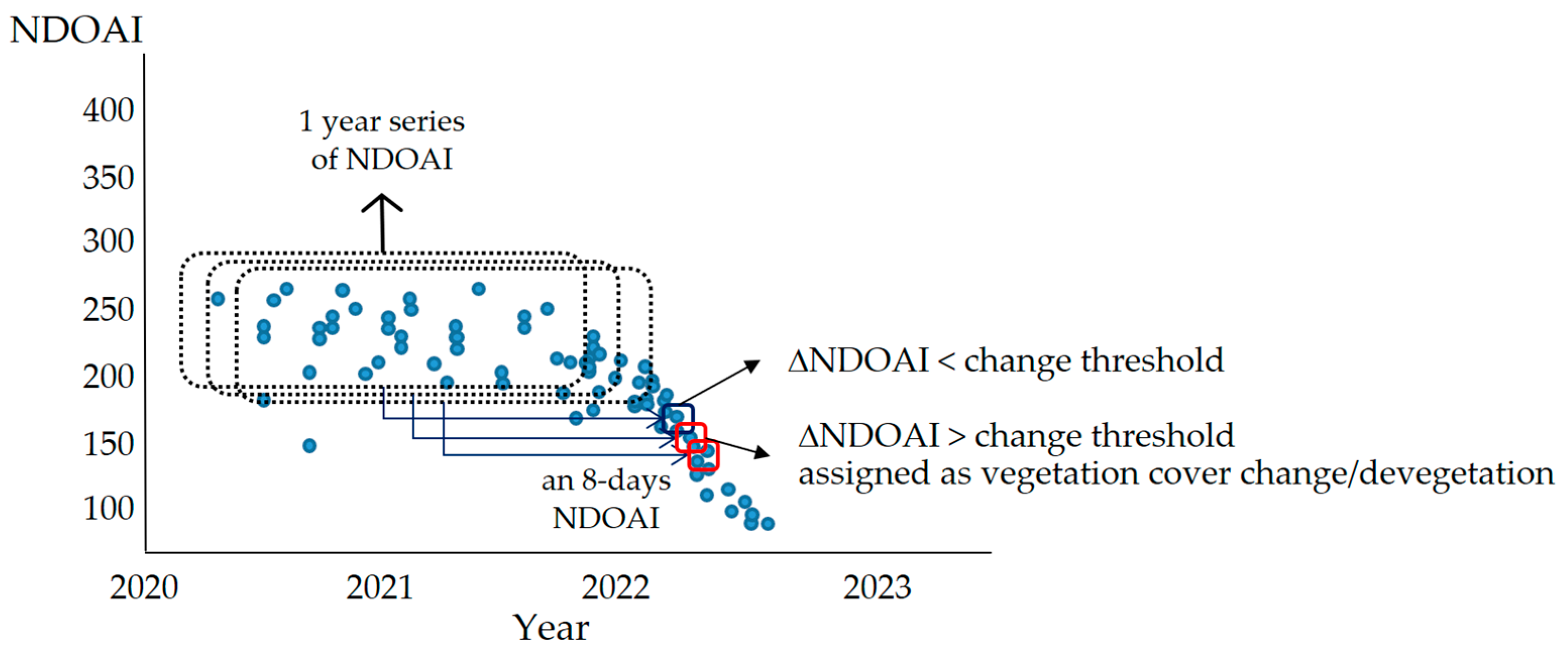
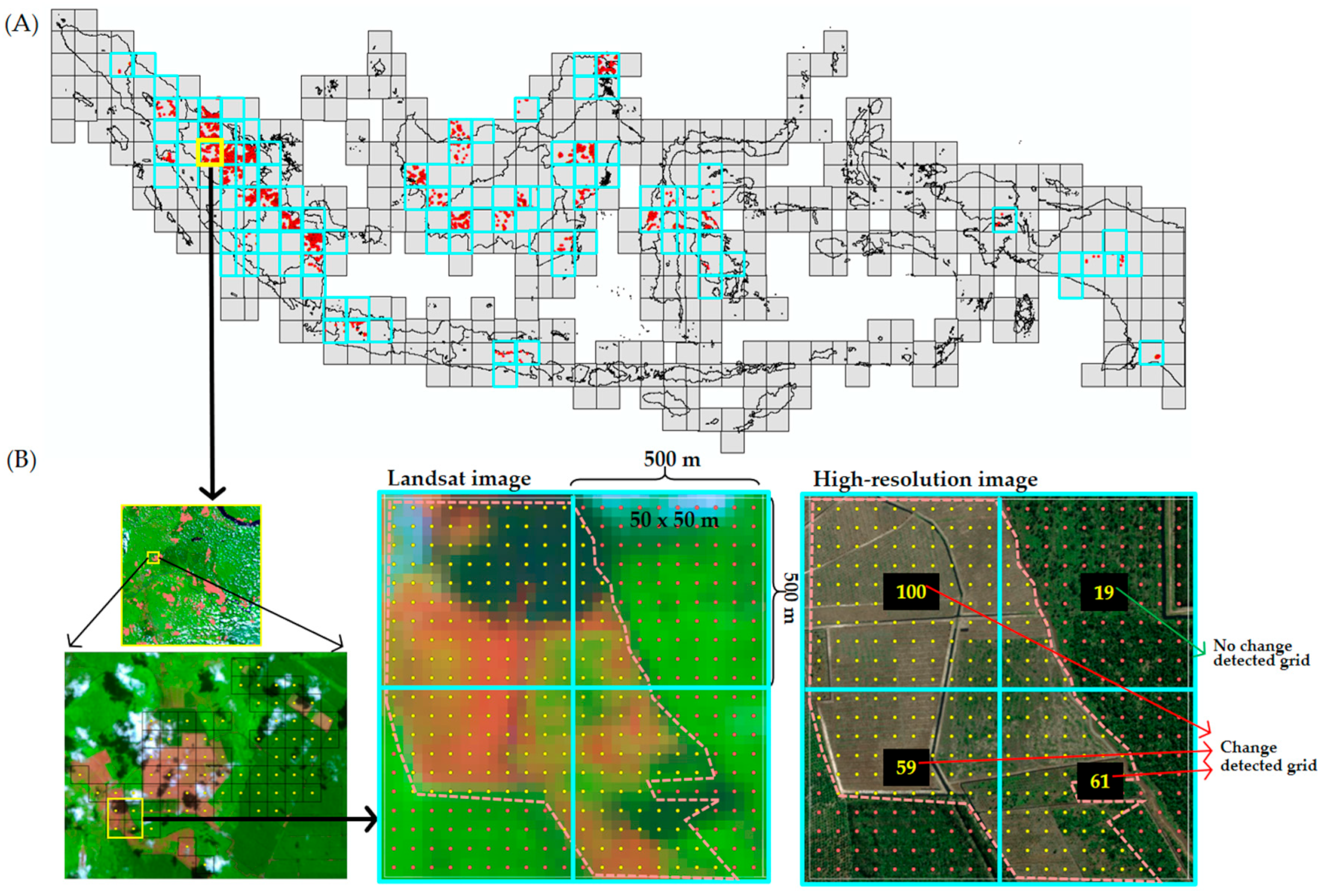
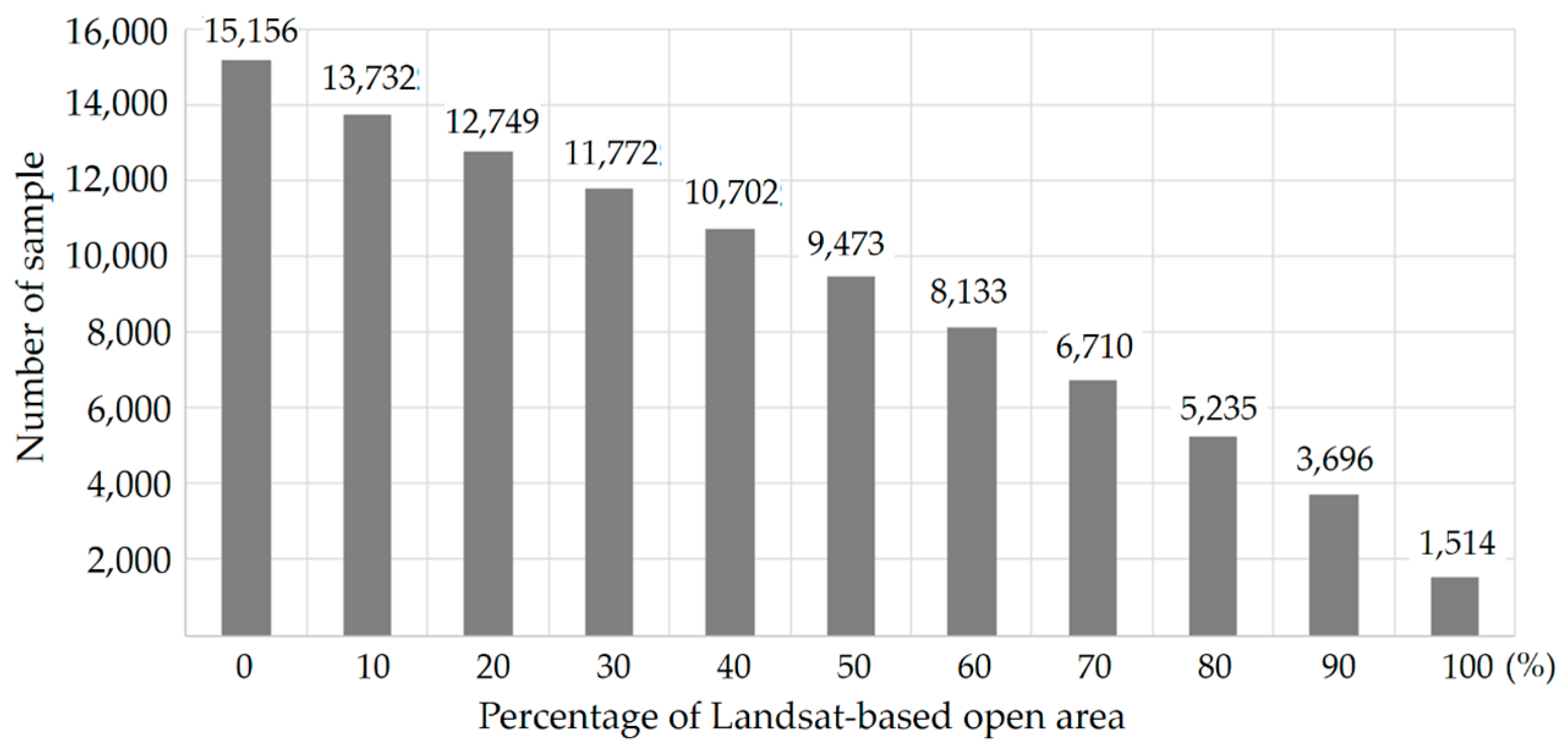
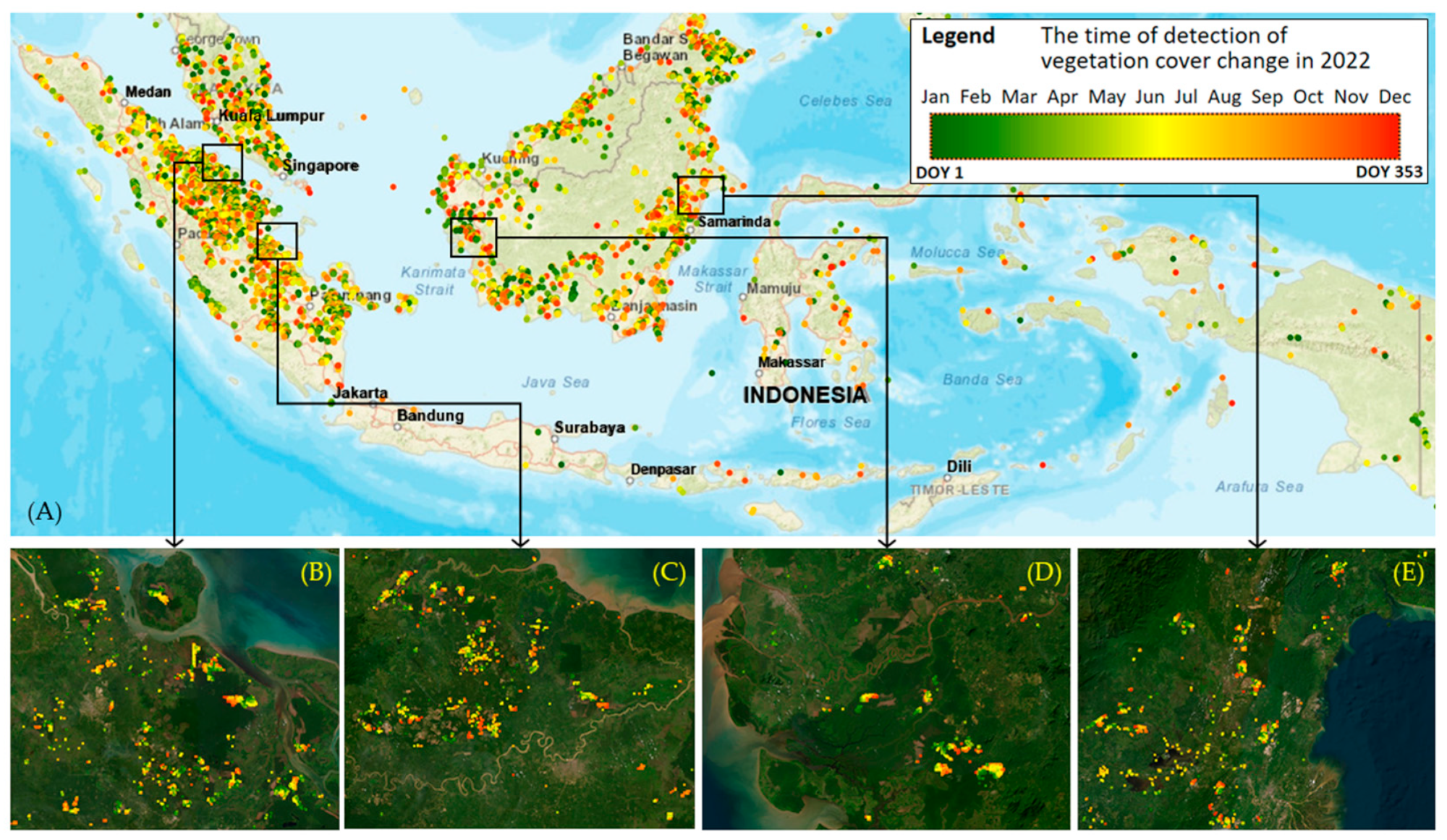
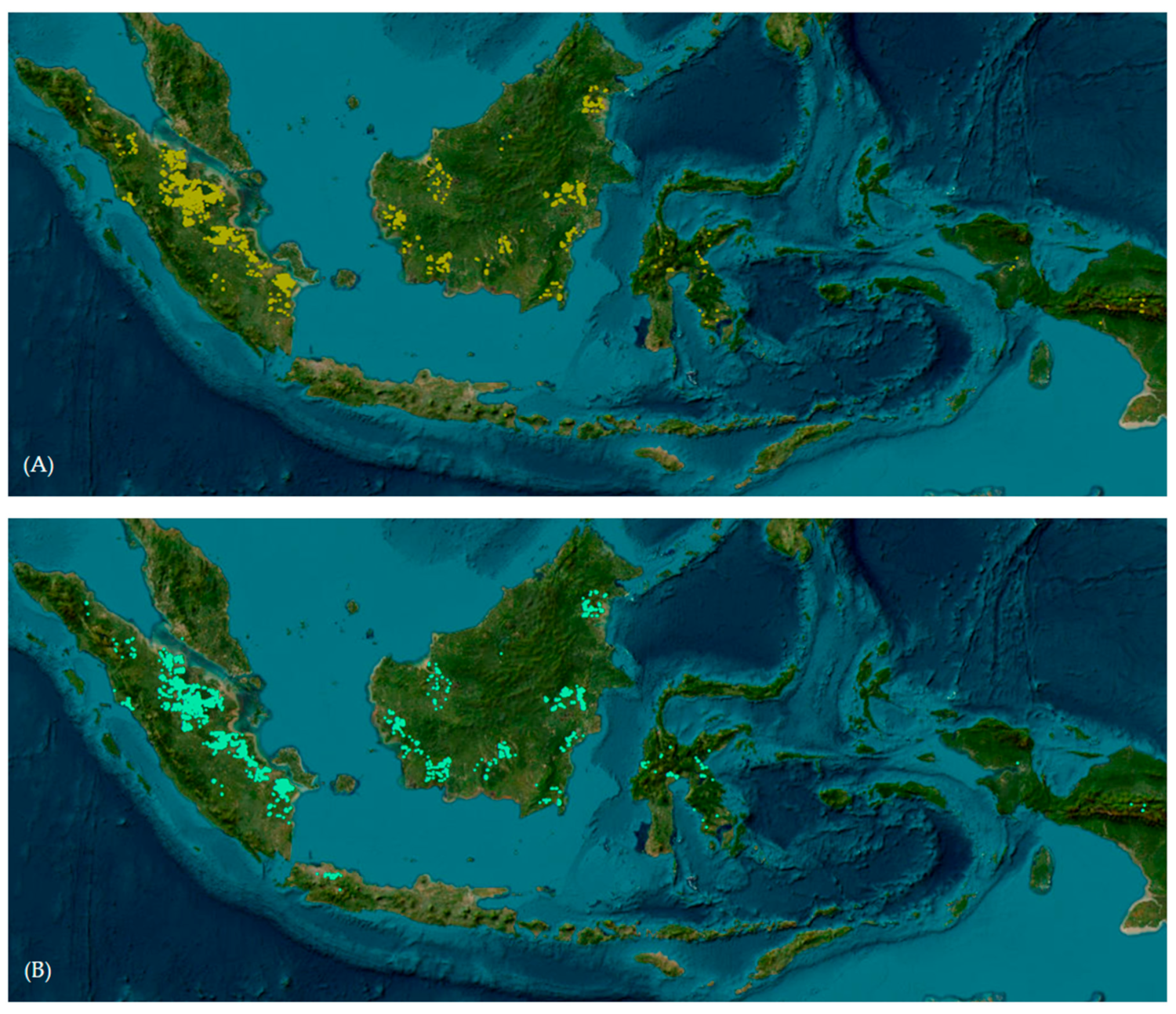
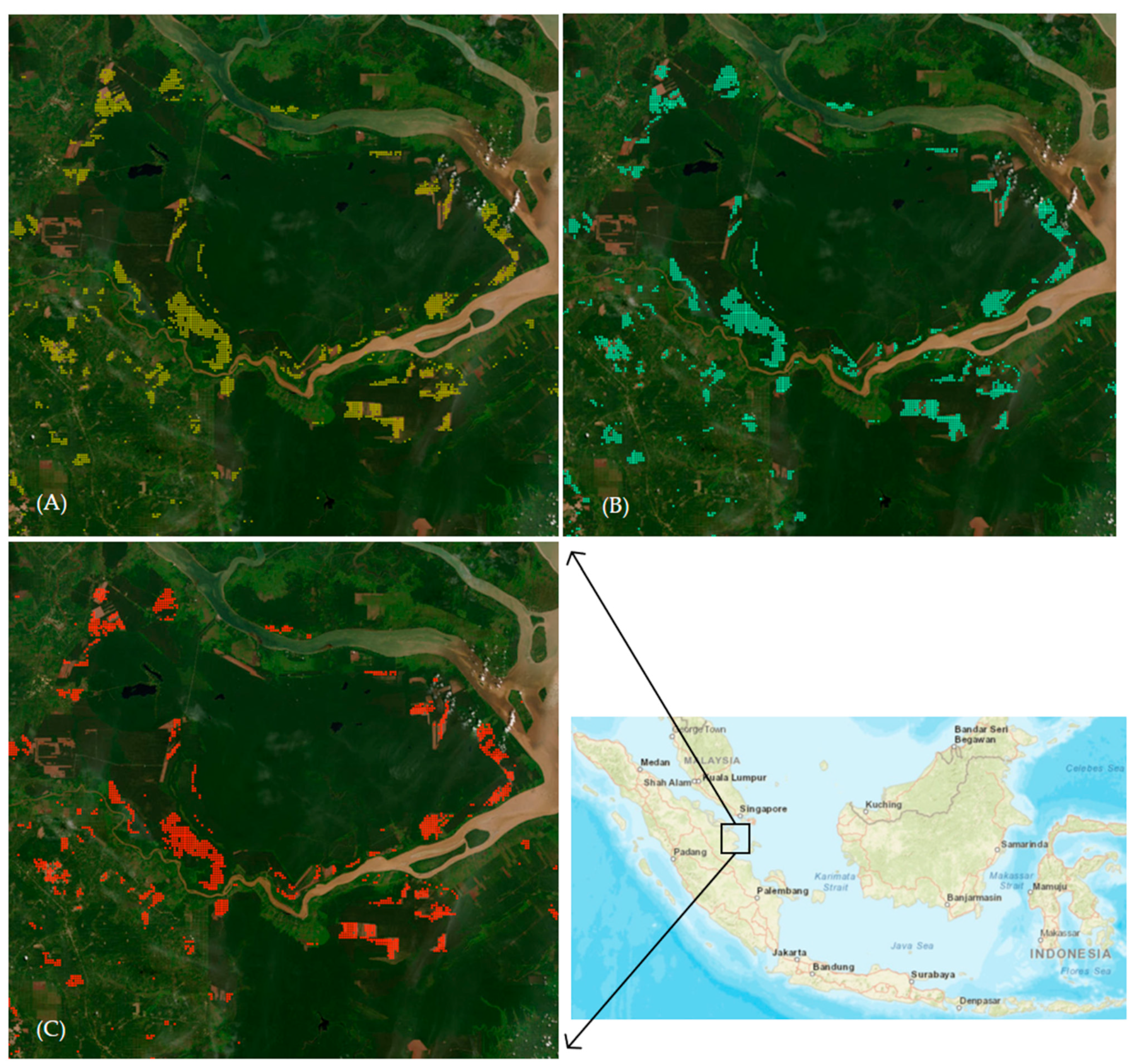
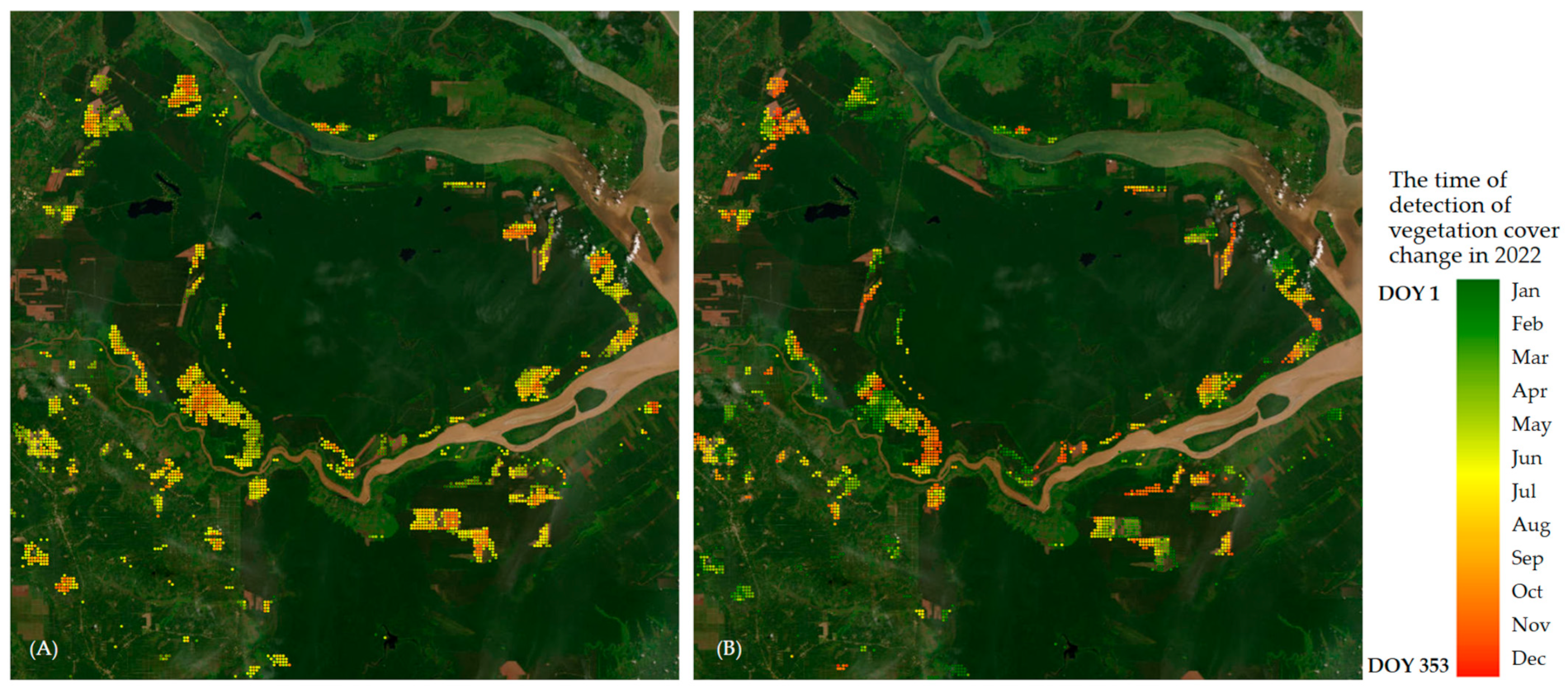
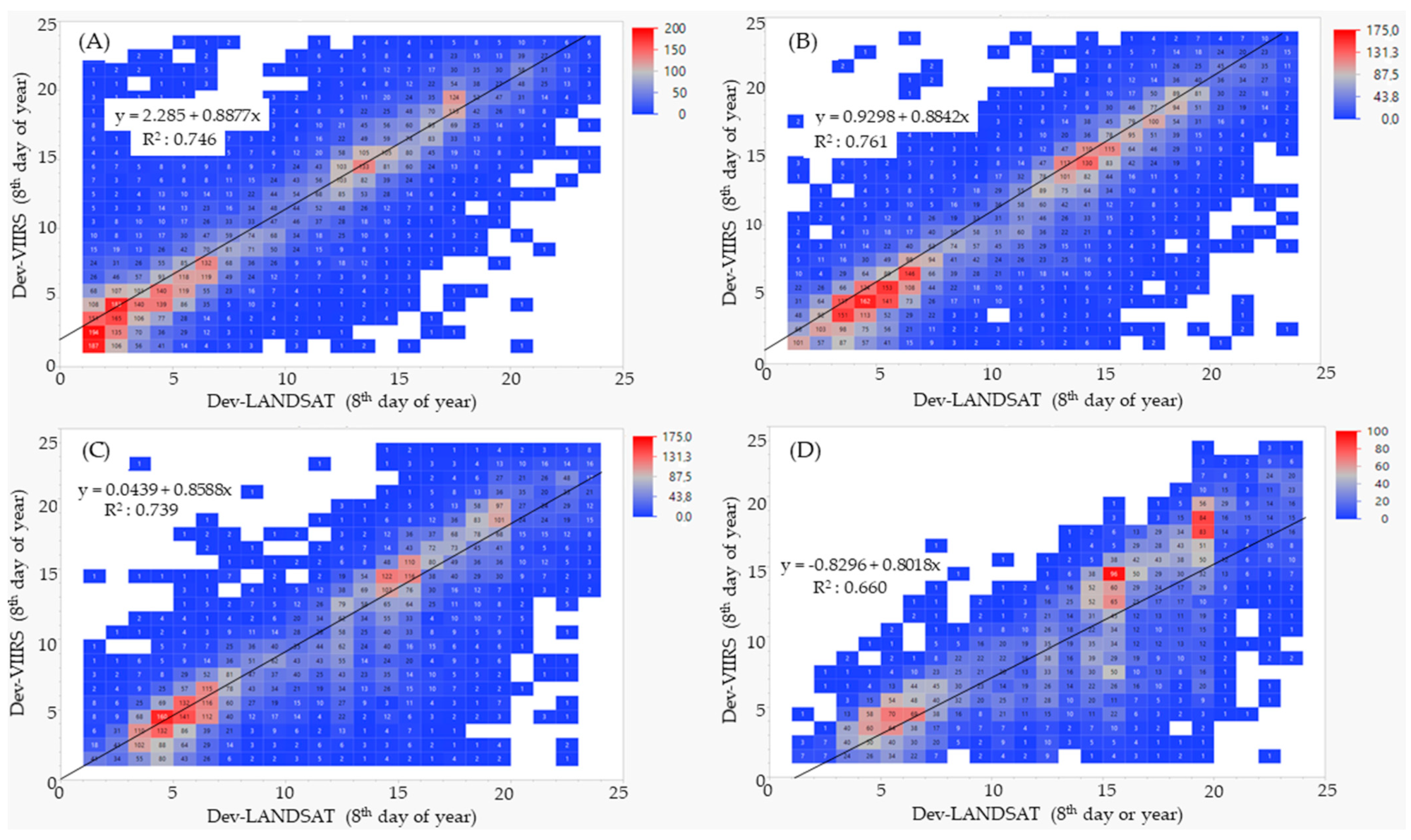
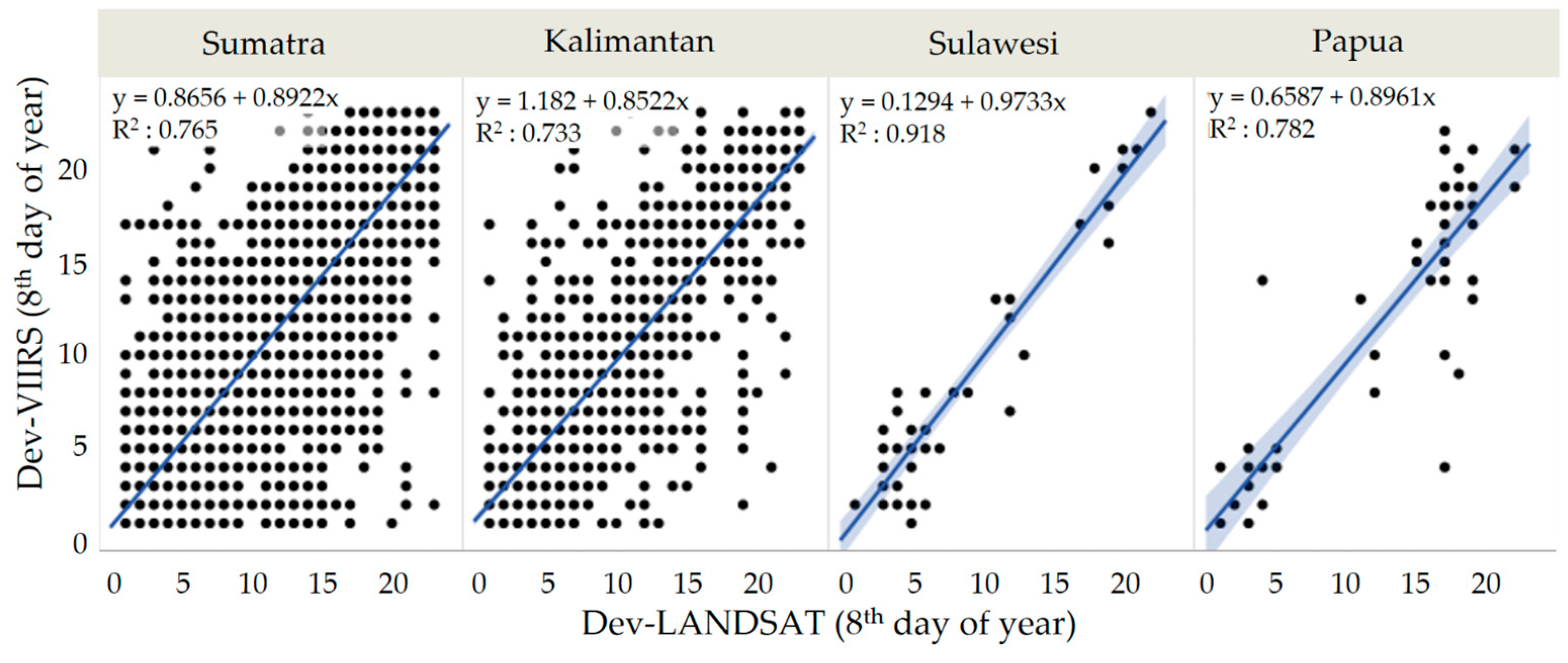
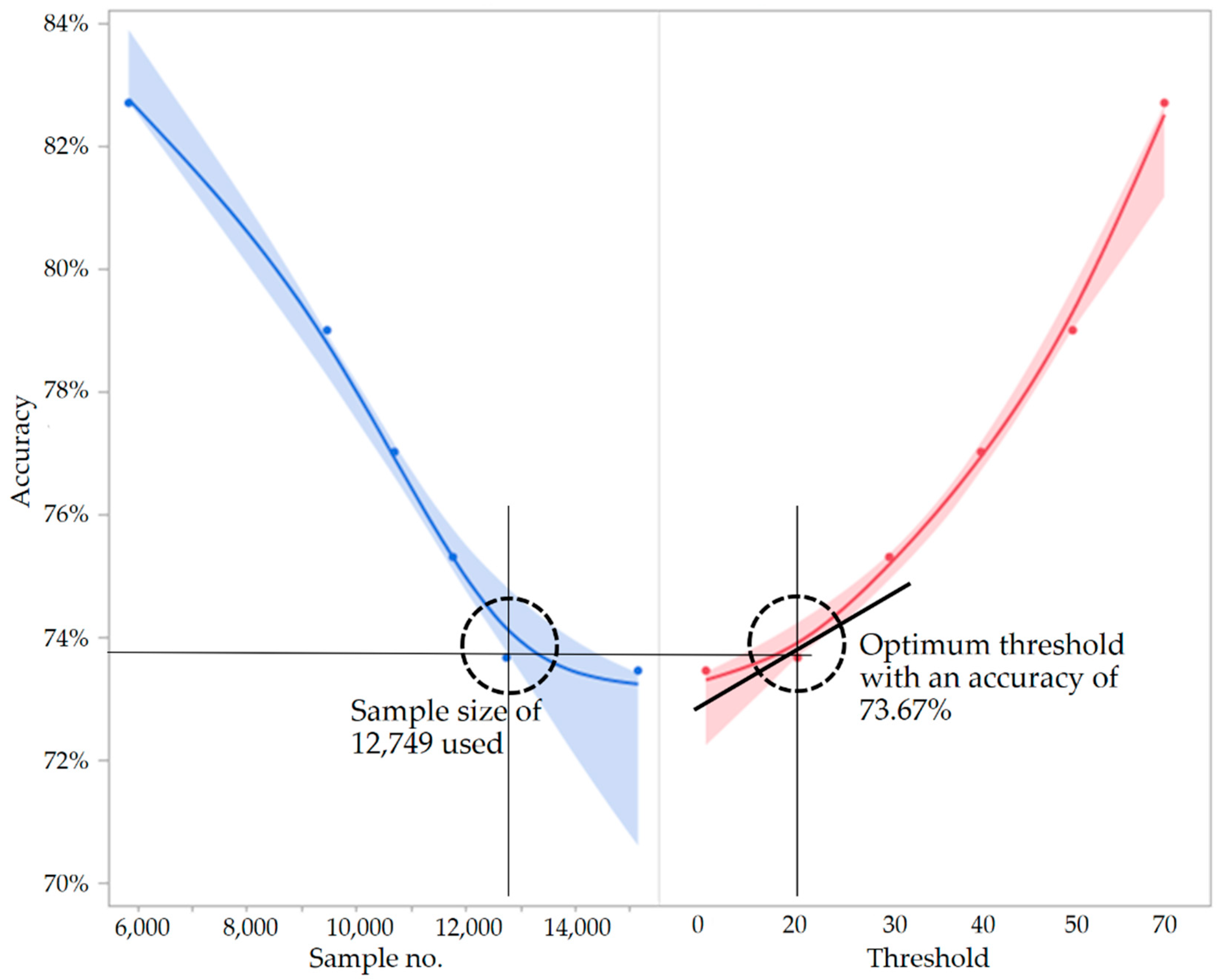

| Percentage of Open Area (Set as the Threshold) | Number of Samples | Omission Err. | Accuracy |
|---|---|---|---|
| ~5% | 15,156 | 31.80% | 68.20% |
| 20% | 12,749 | 26.33% | 73.67% |
| 30% | 11,772 | 24.69% | 75.31% |
| 40% | 10,702 | 22.98% | 77.02% |
| 50% | 9473 | 21.00% | 79.00% |
| 70% | 5844 | 17.30% | 82.70% |
Disclaimer/Publisher’s Note: The statements, opinions and data contained in all publications are solely those of the individual author(s) and contributor(s) and not of MDPI and/or the editor(s). MDPI and/or the editor(s) disclaim responsibility for any injury to people or property resulting from any ideas, methods, instructions or products referred to in the content. |
© 2024 by the authors. Licensee MDPI, Basel, Switzerland. This article is an open access article distributed under the terms and conditions of the Creative Commons Attribution (CC BY) license (https://creativecommons.org/licenses/by/4.0/).
Share and Cite
Setiawan, Y.; Kustiyo, K.; Hudjimartsu, S.A.; Purwanto, J.; Rovani, R.; Tosiani, A.; Usman, A.B.; Kartika, T.; Indriasari, N.; Prasetyo, L.B.; et al. Evaluating Visible–Infrared Imaging Radiometer Suite Imagery for Developing Near-Real-Time Nationwide Vegetation Cover Monitoring in Indonesia. Remote Sens. 2024, 16, 1958. https://doi.org/10.3390/rs16111958
Setiawan Y, Kustiyo K, Hudjimartsu SA, Purwanto J, Rovani R, Tosiani A, Usman AB, Kartika T, Indriasari N, Prasetyo LB, et al. Evaluating Visible–Infrared Imaging Radiometer Suite Imagery for Developing Near-Real-Time Nationwide Vegetation Cover Monitoring in Indonesia. Remote Sensing. 2024; 16(11):1958. https://doi.org/10.3390/rs16111958
Chicago/Turabian StyleSetiawan, Yudi, Kustiyo Kustiyo, Sahid Agustian Hudjimartsu, Judin Purwanto, Riva Rovani, Anna Tosiani, Ahmad Basyiruddin Usman, Tatik Kartika, Novie Indriasari, Lilik Budi Prasetyo, and et al. 2024. "Evaluating Visible–Infrared Imaging Radiometer Suite Imagery for Developing Near-Real-Time Nationwide Vegetation Cover Monitoring in Indonesia" Remote Sensing 16, no. 11: 1958. https://doi.org/10.3390/rs16111958










